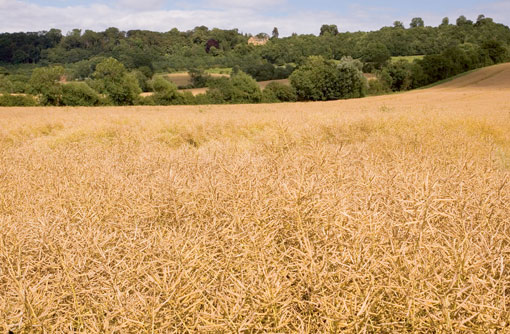Crops responding to trace elements in this dry year

Crop responses to trace element and fungicide applications were two key issues tackled at the recent Frontier Agriculture open day at its Horningsea trials site in Cambridgeshire. Louise Impey went along
Clear benefits are being seen from trace element applications in this dry year, in both cereals and oilseed rape crops, according to trials manager Jim Carswell.
“There’s definitely going to be a reward from trace elements in 2011,” he stressed. “In very dry springs, root systems don’t develop as well as they otherwise would, making it more difficult for the plant to get what it needs from the soil.”
A 0.7t/ha response to magnesium has been recorded in winter wheat in previous Frontier work, he continued. “That’s from a total application of 2.4kg, applied in two hits, at GS31 and again at GS39.”
Most crops will benefit from foliar magnesium, he confirmed. “There are some farms with known deficiencies, but it’s a wider issue than that. If you’re concerned, plant samples can be taken now and sent for testing.”
Problems are also showing up in oilseed rape this year, with yellow/red mottling on leaves being apparent where crops are short of magnesium.
“Ideally, you should apply magnesium to oilseed rape in mid-March, then again 10 days later.”
Boron is another trace element that is needed by winter oilseed rape, advised Mr Carswell. “Our work has shown differences in the requirements of hybrids and conventionals, due to their speed of growth. Apply 600g to hybrids, but increase that to 900g if conventionals are being grown.”
The interaction between sulphur and molybdenum is also being investigated by Frontier, with the work in its first year.
“We know that molybdenum is used for nitrogen utilisation, but there’s also an interaction between nitrogen and sulphur. From what we’ve seen so far, applying molybdenum can make the crop deficient in sulphur – even when sulphur has been applied at recommended rates – because it has an effect on nitrogen.”
Late pod abortion is being seen in some oilseed rape crops, he admitted. “There’s also been an effect of pod midge this year. But where pods have been aborted, it’s a sign that crops are struggling.
“Again, trace elements applied at stem extension, when they’re most needed, have helped prevent this problem being more widespread.”
Variety choice
Growers value consistency more than anything else when making their variety choice, which is why certain varieties are proving hard to replace.
Yield and standing power are at the top of their shopping lists, said Mr Carswell, with disease resistance coming after these two characteristics at current high commodity prices, especially where effective fungicide solutions are available.
“There are other characteristics with certain appeal, such as earliness, but the importance depends on factors such as rotation and workload. With wheat, resistance to orange wheat blossom midge is another grower attraction.”
Hard Group 4 wheat KWS Santiago will sell well, he predicted. “With a treated yield of 108%, it’s attracting a great deal of farmer interest. But it is later than some of the feed varieties they’ve been growing up until now.”
Other high-yielding feed wheats with consistency on their side include JB Diego and Oakley, he pointed out. “There’s also Grafton, which is an early type and good where oilseed rape is the following crop, and Conqueror, which seems to be enjoying the dry season.”
Hybrids are faring much better than conventional oilseed rape varieties this year, showing that they are more able to cope with dry springs and extreme conditions, he said.
“It’s due to their bigger root systems. All growers should consider part of their oilseed rape area being in a hybrid, for risk management purposes.”
Fungicide programmes
Responses to fungicides are expected to be very low in 2011, given the general absence of disease, reported Frontier agronomist Bob Mills.
Work looking at yield and quality responses to various fungicide programmes isn’t expected to reveal any surprises, he admitted.
“It’s a great shame because we’ve got both new varieties and new chemistry in the trial. Even the claimed drought tolerance benefits of certain products aren’t likely to be evident, as the drought has been so severe.”
It’s the second year running that responses have been minimal. “No wonder growers are questioning the need for some sprays.”
| Drought implications • Get your seed orders in, as lower yields will mean that seed supplies will be very tight • If it remains dry, consider increasing seed rates this autumn • Choice of cultivations may have to reflect the need to preserve seed-bed moisture • Nitrogen offtake could be lower than usual |
|---|

